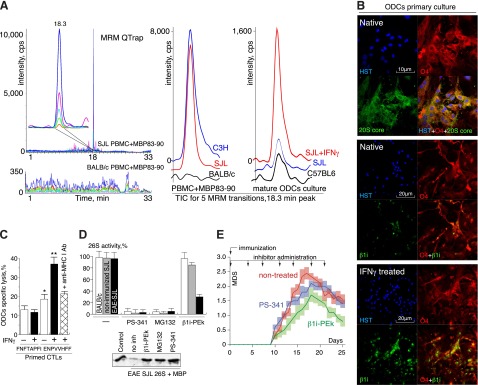Figure 6.

IP subunit β1i is a specific target for treatment of autoimmune demyelination. A) Extracted ion chromatograms (monitoring of 5 transitions corresponding to the MBP83–90 peptide) obtained by MRM QTRAP mass spectrometry analysis of peptide extracts of SJL- and BALB/c-derived PBMCs loaded with MBP83–90 peptide are shown at left. Total ion current chromatography peak (18.3 min) obtained by MRM QTRAP mass spectrometry analysis of peptide extracts of SJL-, C3H-, and BALB/c-derived PBMCs loaded with MBP83–90 peptide (middle) and peptide extracts of mature ODCs cultures from C57BL/6 and SJL mice (right). B) Staining of mature ODC culture treated with or without IFN-γ for O4 ODC marker, core 20S subunits and β1i. HST, Hoechst 33342. C) Lysis of mature ODCs treated with or without IFN-γ by CTLs specific for MBP peptide ENPVVHFF (MBP83–90) and control peptide FNFTAPFI. Percentage of lysed target cells was estimated using DELFIA cytotoxicity assay. Anti–MHC class I Ab indicates ODCs treated with antibody specific for mouse MHC class I. Data are presented as means ± sem (n = 3); *P < 0.05, **P < 0.01. D) Activity of proteasomes from BALB/c, immunized, and nonimmunized SJL mice toward LLVY-MCA (top) and MBP (bottom) was monitored in the presence of proteasome inhibitors. Data are presented as means ± sem (n = 3). E) Mean disease scores of SJL mice developing EAE treated with β1i-PEk (0.5 mg/kg) and PS-341 (0.5 mg/kg) compared to untreated animals. Proteasome inhibitors or vehicle control were administrated twice weekly starting from day 0 after immunization, 7 times total. Error bars represent standard deviations.
